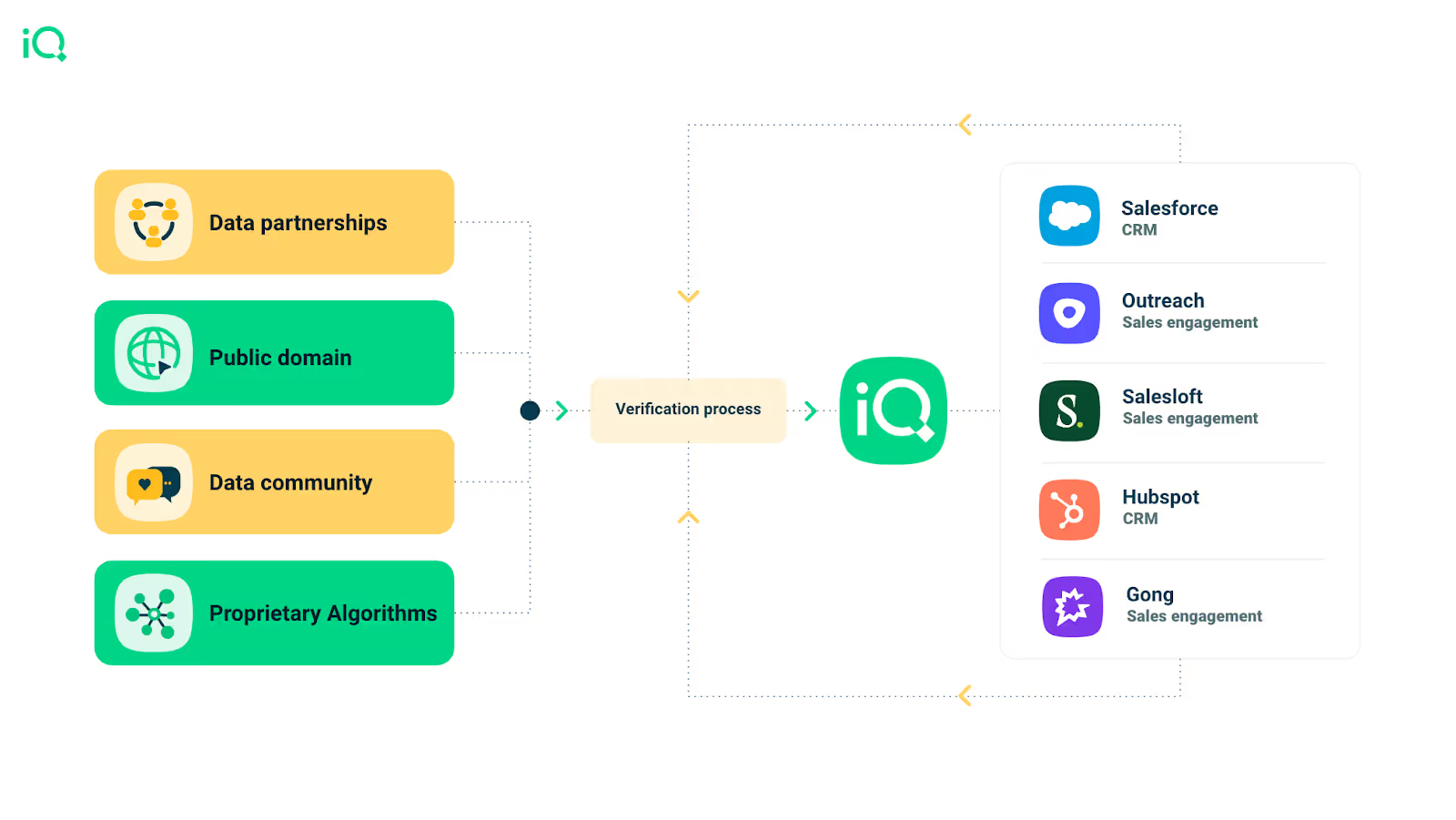Ready to create more pipeline?
Get a demo and discover why thousands of SDR and Sales teams trust LeadIQ to help them build pipeline confidently.

.avif)

Frequent job changes and layoffs contribute to outdated contact data, leading to low response and connect rates.

Most B2B contact databases use similar data sources, making it difficult for teams to differentiate between providers. This results in repeated cycles of purchasing data that quickly becomes obsolete.

Unlike legacy providers, LeadIQ focuses on continuously verifying and activating high-quality, relevant data. This approach reduces bounce rates and improves the accuracy of prospecting, helping teams achieve better results.
Get a demo and discover why thousands of SDR and Sales teams trust LeadIQ to help them build pipeline confidently.
Imagine you’re in the market for a new B2B data provider. As you start researching your options, you expect that every potential solution will offer several distinct advantages that make them stand out. You spend your time trying to drill down into the specifics of each contact database to figure out the differences in how they source data, but you’re struggling to come up with any convincing answer.
What you don’t realize is that this is more or less by design.
There’s an elephant in the room that most B2B contact database providers never want to talk about: where their data actually comes from.
The reason you can’t figure out the differences between the way each data provider sources data is that there pretty much aren’t any.
You read that correctly: Most B2B contact database providers all use data that generally originates from the same place.
Contact databases are filled with information that B2B sales teams need, including company information, contact information, and industry-specific data. These databases play a critical role in helping teams analyze TAM, research target industries and accounts, increase lead generation velocity, and tailor outreach.
Unfortunately, we’ve seen an accelerated trend of companies conducting layoffs as well as workers increasingly switching jobs. Based on observations within our own data, we’ve detected 5.37 million job changes, or roughly 500,000 per month, just this year. That being the case, unless you’re leveraging a contact tracking solution or are continuously updating Salesforce records, much of your CRM data will decay rather quickly.
As a result, cold call phone connect rates have been plummeting; while results vary across different personas and industries, our recent data shows that, on average, only 2%–5% of calls to mobile phones are answered.
As such, sales teams are facing declining win rates, which have dropped from 26% to 17% over the last 18-odd months, according to Winning by Design. This, in turn, is putting more pressure on pipeline generation.
At the same time, there’s increased competition in every space. Believe it or not, there are 11,000 vendors in the martech space — up from 5,000 just five years ago. Similarly, there are over 200 data vendors on the market today, giving sales teams tons of options — or so it seems.

When sales teams continue to use inaccurate data for prospecting, they end up wasting time and money, and their pipeline numbers start to slip. When that happens, they blame the data and often begin looking for yet another B2B contact database.
They expect a new provider will solve their data accuracy problems, but since all databases pretty much use the same data sources, they find themselves in the same situation in the not-so-distant future, and they’re back to the drawing board once again.
This cycle is the result of a confluence of factors:
Over the last 10 to 15 years, legacy B2B data providers have all focused on cramming as much data into their products as they could to cast the widest net and appeal to as many verticals as possible. They opted to prioritize sourcing tons of data over ensuring that the data was accurate, and the trade-offs of that decision are coming into crystal-clear focus today.
Lacking the controls needed to verify and confirm data is accurate, legacy B2B contact data providers simply can’t keep pace with the velocity at which employees switch jobs today. At the same time, since legacy providers try to jam as much data into their databases as they can, sales reps who use these products are overwhelmed with information. Since they can’t use all of the data at once, large data sets sit on the sidelines collecting proverbial dust. When reps finally get around to deploying the data, they find out the hard way it’s not reliable, which makes it that much more difficult to hit their goals.

Since we launched in 2015, LeadIQ has always thought about data differently.
Instead of trying to amass as much B2B contact data as we can, we stay focused on the data our customers actually want and will actually use. Since the Pareto Principle tells us that 80% of sales outcomes will originate from 20% of the data, we focus on quality over quantity.
At the same time, we are constantly verifying our data to ensure it’s accurate. We do this by sourcing data from the public domain, engaging with data communities, forging data partnerships, conducting ideal customer profile (ICP) exercises with our customers, and using our proprietary algorithm to proactively verify up to 90 million records of data every month.
LeadIQ uses artificial intelligence and machine learning to verify data at the source and ensure its integrity before it reaches our customers. As a result, sales teams can put LeadIQ’s data into use with confidence.
Our investment in data has returned significant dividends. Over the last year, we’ve seen improvements related to customers accessing more mobile numbers for their prospects as well as reductions in hard-bounced emails for U.S.-based leads. While the success rate for obtaining a prospect’s mobile number increased by 67%, the hard-bounce rate decreased by 1.68x to almost under 4% for verified emails when comparing the second half of 2022 to the first half of 2023.
All this said, data is only one piece of the pipeline puzzle. Our platform is purpose-built to tackle all aspects of prospecting from start to finish — including capturing prospect data, tracking sales triggers, and automatically enriching CRM records.
Add it all up, and LeadIQ enables GTM teams to activate accurate data and streamline prospecting workflows — making it that much easier to hit pipeline goals.
If sales and GTM teams want better results, they need better solutions and better data. But more than that, they also need to be able to activate that data quickly and confidently, ensuring that they’re able to reach the right person at the right time, every time.
To accelerate pipeline generation, GTM teams also need to be able to increase operational efficiency by automating recurring tasks and use process benchmarking tools to continuously optimize their efforts.
At LeadIQ, we’re committed to ensuring our customers are always equipped with highly accurate, highly actionable data. Once GTM teams experience the LeadIQ difference, they can’t imagine prospecting without it.
Interested in learning more about how LeadIQ is modernizing B2B contact data and prospecting workflows? Get in touch with one of our prospecting experts and book a demo today.
.avif)